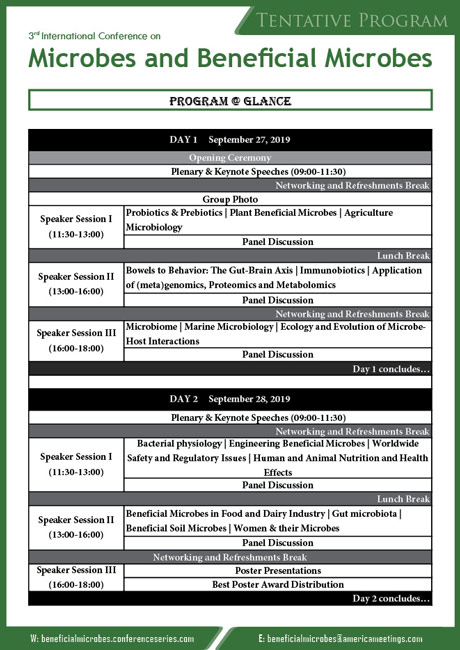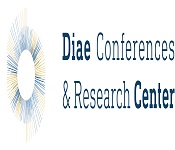
Join Beneficial Microbes 2019 in Toronto, Canada during September 27-28, 2019
Beneficial Microbes 2019 | Sept 27-28, 2019 | Toronto, Canada




3rd International Conference on Microbes and Beneficial Microbes
Probiotics Conferences in USA, Canada, Europe
Theme: Milestone Technologies of Beneficial Microbes for human and animal health
Beneficial Microbes 2019
Conference Series LLC Ltd invites all the participants from all over the world to attend 3rd International Conference on Microbes and Beneficial Microbes during September 27- 28, 2019 at Toronto, Canada which includes keynote presentations, Oral talks, Poster presentations, Video Presentations and E-poster Presentations.
3rd International Conference on Microbes and Beneficial Microbes aims to bring together leading academic scientists, researchers and research scholars to exchange and share their experiences and research results on all aspects of Microbes, Beneficial Microbes,. It also provides a premier interdisciplinary platform for researchers, practitioners and educators to present and discuss the most recent innovations, trends, and concerns as well as practical challenges encountered and solutions adopted in the fields of Biology, Beneficial Microbes, Microbiology, Mycology, Zoology, Probiotics Biotechnology, Pharmacy, Agriculture.
Why to attend:
- Platform to access incredible speakers, experts and influencers face to face .
- Opportunity to grab tips and tactics from leading industrialists and eminent speakers in the fields of Probiotics, Prebiotics, Microbiome and Agriculture .
- Opportunity to share and explore your research ideas to be more productive .
- Chance to collaborate with global business delegates and researchers.
- This conference acts as a dais for introducing new ideas and approaches.
Details of Beneficial Microbes Conference in 2019 in Canada:
Conferenceseries.com organizing Beneficial Microbes Conference in 2019 in Canada. We organize Synbiotics Meetings in the fields related to it like Probiotics and Prebiotics.
| Conference Name | Place | Date |
|---|---|---|
| Beneficial Microbes 2019 | Toronto, Canada | September 27- 28, 2019 |
Session/ Tracks :
Probiotics are contained with a range of food and nutrition products such as dietary supplements, medicinal foods, biopharmaceuticals and medical devices delivering probiotics. Prebiotics foods are taken as dietary ingredients to maintain the Biological Symbiosis with the microbial flora. Dietary supplements created through the synergism of Pro and Pre-biotic are the Synbiotics. The nutrition supplemented with the beneficial microbial flora and the associated microbiome in human gut, restoring the human digestive system as a whole is said to be the “Probiotics”.
- Synbiotics
- Pediatric Nutrition
- Probioceuticals​
- Probiotics for Women Health
- Probiotics and Recombinant Probiotics
- Non-LAB Probiotics – Bifidobacteria, Yeasts, Bacilli
- Future of Probiotics and Prebiotics – Visions and Opportunities
Agricultural microbiology which is the most important field of Microbiology for the economic and medical importance it holds. This field explores various aspects like the genetics, physiology, molecular biology, virulence & pathogenicity and other aspects of the plant microbes. It deals with the infectious agents of the microbes, improvements and resistance of the agricultural crops, economic importance and the beneficial aspects of the normal agricultural flora. A complete study and understanding is crucial in application of the microbes for augmentation of soil nutrients, which is increasing the resistance of plants against the plant pathogen, for understanding the interaction a microbe has with the plant, and crop robustness.
- Food microbiology
- Bio-fertilizer Production
- Fermentation technology
- Soil and Applied Microbiology
- Use of microorganisms to the soil fertility.
- Microorganisms to control illnesses and pests.
Soil microorganisms are the most abundant of all the biota in soil and responsible for driving nutrient and organic matter cycling, soil fertility, soil restoration, plant health and ecosystem primary production. Beneficial microorganisms include those that create symbiotic associations with plant roots (rhizobia, mycorrhizal fungi, actinomycetes, diazotrophic bacteria), promote nutrient mineralization and availability, produce plant growth hormones, and are antagonists of plant pests, parasites or diseases (biocontrol agents). Many of these organisms are already naturally present in the soil, although in some situations it may be beneficial to increase their populations by either inoculation or by applying various agricultural management techniques that enhance their abundance and activity.
- Rhizobia
- Biocontrol fungi
- Growth Promoting Bacteria
- Nitrogen (N2) Fixing Bacteria
The ability of gut microbiota to communicate with the brain and thus modulate behavior is emerging as an exciting concept in health and disease. The enteric microbiota interacts with the host to form essential relationships that govern homeostasis. Despite the unique enteric bacterial fingerprint of each individual, there appears to be a certain balance that confers health benefits. It is, therefore, reasonable to note that a decrease in the desirable gastrointestinal bacteria will lead to deterioration in gastrointestinal, neuroendocrine or immune relationships and ultimately disease.
- Citrobacter Rodentium
- Modulation of the Intestinal Micro-flora
- Infection, central activation and behavior
- Inflammatory Bowel Disease and Crohn’s Disease
- Probiotics and behavior/central neurotransmitters
- Behavioral and neurochemical consequences of growing up germ-free
The term “Immunobiotics” has been proposed to define microbial strains able to beneficially regulate the mucosal immune system. Over the past few years, we have witnessed the emergence of robust development in the application of immunobiotics to combat infections, and researchers have found that the use of beneficial microbes is an interesting alternative to prevent and reduce the severity of infections in humans and animals. The effect of immunobiotics on the gut innate and adaptive immune responses to enteric pathogens has been recognized conclusively the influence of immunobiotics on the immune responses in distal mucosal sites and its impact in the outcome of respiratory infections has recently been exposed.
- Pathogens
- Beneficial microbes
- Immunobiotic strains
- Influenza virus infection
Oral microbiology is the study of the microorganisms (microbiota) of the oral cavity and their interactions between oral microorganisms or with the host. Microbes within dental plaque as the cause of dental and periodontal diseases. The collective function of microbial communities is a major driver of homeostasis or dysbiosis and ultimately health or disease. Despite different aetiologies, periodontitis and caries are each driven by a feed forward loop between the microbiota and host factors (inflammation and dietary sugars, respectively) that favours the emergence and persistence of dysbiosis.
- Periodontitis
- Microbiota
- Homeostasis
- Dysbiosis
A microbiome is the community of microorganisms such as bacteria, archaea, fungi, as well as viruses that inhabit an ecosystem or organism. Microorganisms dominate all other life everywhere scientists have looked, including the human body, the Earth’s soils and sediments, the oceans and fresh waterways, the atmosphere and even extreme environments such as hydrothermal vents and subglacial lakes. Scientists also use the term microbiome to refer to all these genes associated with those life forms.
- The Earth Microbiome
- The Ocean Microbiome
- The Animal Microbiome
- Modulation of Microbiota
- The Human Microbiome
- The Atmospheric Microbiome
Marine microbiology is the study of microorganisms and non-organismic microbes that exist in saltwater environments, including the open ocean, coastal waters, estuaries, on marine surfaces and in sediments. Aquatic microbiology is the science that deals with microscopic living organisms in fresh or salt water systems. Aquaculture & Marine Biotechnology helps to control the marine organisms and water borne organisms. It is a process which has to do with marine or underwater environment. Blue Biotechnology is used to protect the marine organisms from harmful diseases underwater. The control of seasonal production and reproduction in farm animals has become major research goals. The applications of biotechnology to fish farming and ornamental fish production are numerous and valuable in both economic (food production, aquarium trade) and environmental terms (conservation of natural biodiversity for endangered species and protection of natural biodiversity from escapee domesticated strains). With the growing demand for fish products, biotechnology can help in the development of high quality, economical produce, thereby reducing pressure on natural population.
- Applications of Marine Biotechnology
- Marine Microbiology and Biodiversity
- Biotechnology applications to Aquaculture
- Marine-based Drug Discovery and Development
- Environmental Risk of Aquatic Organisms from Genetic Biotechnology
Microbes are typically surrounded by different strains and species with whom they compete for scarce nutrients and limited space. Given such challenging living conditions, microbes have evolved many phenotypes with which they can outcompete and displace their neighbours: secretions to harvest resources, loss of costly genes whose products can be obtained from others, stabbing and poisoning neighbouring cells, or colonising spaces while preventing others from doing so. These competitive phenotypes appear to be common, although evidence suggests that, over time, competition dies down locally, often leading to stable coexistence of genetically distinct lineages. Nevertheless, the selective forces acting on competition and the resulting evolutionary fates of the different players depend on ecological conditions in a way that is not yet well understood. Here, we highlight open questions and theoretical predictions of the long-term dynamics of competition that remain to be tested. Establishing a clearer understanding of microbial competition will allow us to better predict the behaviour of microbes, and to control and manipulate microbial communities for industrial, environmental, and medical purposes.
- Social Evolution.
- Bacteria Communities
- Bacterial pathogenomics
- Host–microbe interactions
- Interference and Exploitative competition
- Manipulation of host-cell pathways by bacterial pathogens
- An ecological and evolutionary perspective on human–microbe mutualism and disease
Demands for food, animal feed, and feedstocks for bioenergy and biorefining applications, are increasing with population growth, urbanization and affluence. Low-input, sustainable, alternatives to petrochemical-derived fertilizers and pesticides are required to reduce input costs and maintain or increase yields, with potential biological solutions having an important role to play. Plant–microbe interactions span a wide range of relationships in which one or both of the organisms may have a beneficial, neutral or negative effect on the other partner. A relatively small number of beneficial plant–microbe interactions are well understood and already exploited; however, others remain understudied and represent an untapped reservoir for optimizing plant production. There may be near-term applications for bacterial strains as microbial biopesticides and biofertilizers to increase biomass yield from energy crops grown on land unsuitable for food production. Longer term aims involve the design of synthetic genetic circuits within and between the host and microbes to optimize plant production. A highly exciting prospect is that endosymbionts comprise a unique resource of reduced complexity microbial genomes with adaptive traits of great interest for a wide variety of applications.
- Energy and microbes
- Bacterial endophyte
- Food and microbial engineering
- Genetic engineering of microbes
- Metabolic engineering and synthetic biology
- Biomedical engineering and microbiological researches
Visa
Any foreign national who is not a citizen of Canada or does not have visa exemption or Electronic Travel Authorisation (ETA) agreement may apply for a visa to enter the country. The Canadian Government issues the following two types of visas to foreign nationals:
- Temporary Canada Visa
- Permanent Canada Visa
Temporary Canada Visa: The temporary Canada visas allow the person to stay in Canada for a specific period of time. This time is usually up to 6 months. However, the temporary visa can be single entry or multiple entry visas.
Single entry visa allows the person to only enter Canada once, stay for 6 months and then return to their home country. A multiple entry visa allows the person to enter Canada multiple times until their visa expires and stay temporarily. The list of temporary Tourist Visa are:
1. Tourist Visa: Tourist visa allows the holder to enter Canada for the purposes of tourism in the country.
2. Super Visa: It allows parents or grandparents of Canadian citizens or Canadian Permanent Residents to visit their children or grandchildren for an extended stay.
3. Diplomatic and Official Visa: It gives permission to officials and diplomats from foreign countries to enter Canada for official duties and purposes.
4. Courtesy Visa: It is given to all those people who do not qualify for a Diplomatic and Official Visa but are considered of importance due to their ranks and positions
5. Facilitation Visa: They are given to Canadian citizens with dual nationalities who do not have a Canadian passport but have a passport of another nationality.
6. Business Visa: It is given to those who are traveling to Canada with business purposes as individuals or as a group of business people.
7. Giving Birth Purpose visa: It is given to people who fulfill all the criteria to stay temporarily in Canada and who are pregnant and want to give birth in the country. Giving birth in Canada makes the baby automatically a Canadian citizen.
8. Organ Donors Visa: It is given to a person who is traveling to Canada with the purpose of donating an organ to a Canadian citizen or Permanent Resident.
9. Student Visa: It is given to those who have an admission from a Canadian university to complete their studies. If you are going to Canada to study for less than 6 months, then you can only get a general visa, but for more than 6 months of studies, you will need a Student Visa.
10.Temporary Foreign Workers: These are given to those people who have a job offer in Canada and will work for up to 6 months. To get this visa, the person must present a valid job offer letter from an employer and qualify for a temporary visa.
11. Temporary Resident Permit: This permit is for people who need to go to Canada for different purposes but are otherwise not admissible for a Temporary Resident Visa (TRV).
Permanent Canada Visa: The permanent Canada visas are visas which allow the holder to permanently settle in the country. These are otherwise known as immigrant visas and can be of different types, as follows.
1. Federal Skilled Trades Programme (FSTP): This visa is given to people who are qualified tradespeople in occupations such as Carpenters, Aircraft Mechanics, Crane Operators, Heavy-duty Equipment Mechanics, Electricians, Machinists, Ironworkers, Welders, Plumbers, etc.
2. Federal Skilled Workers Programme (FSWP): This visa is given to people who have professions which are required in Canada. You must check what kind of occupations Canada needs at the point you are planning to apply and obtain the necessary points.
3. Provincial Nomination Programme (PNP): This visa is given to semi or low-skilled workers who can contribute to the Canadian economy through their work. The workers are placed in different provinces of Canada where the demand for their work is higher.
4.Quebec Selected Skilled Worker Programme: If you have one of the occupations which are required in the Canadian province of Quebec and you are fluent in French, then you can apply for this visa which will allow you to move and work permanently there.
5. Family Sponsorship Programme: This visa allows the spouses and dependent children of Canadian citizens or Permanent Residents to immigrate to Canada permanently.
6.Live-in Caregiver Programme: This visa is given to caregivers who are qualified to take care for the elderly, disabled people or children and live in a private home in Canada.
7. Canadian Experience Class: This type of immigrant visa is given to those who have a temporary student visa or a temporary workers visa and want to switch to a permanent resident status.
8.Business Immigrant Visa: It Contains three subtypes:
- Immigrant Investor Programme: The Immigrant Investor Program is for people who will make investments in the Canadian economy
- Entrepreneur Programme: The Entrepreneur Program is for people who will be individually involved in contributing to the economy.
- Self-Employees Persons Programme: The Self-employed Persons Program is for people who have skills in business, athletics, culture, or farming and can start their own businesses
How to apply:
Step-1: Read complete information on the visa/permit requirements on the Canada website and download the appropriate application forms and checklist relevant to the purpose of your visit. Please refer to the “VISA TYPES” page to obtain details on visas/permits.
Step-2: Pay visa fees as per instructions in the Canadian Visa Office website.
Step-3: Book your slot for the Visa Interview and attend the Canadian Embassy with all the documents on that particular date
Step-4: Fill out the application form and other relevant documents electronically and print. Forms (including the barcoded sheets) are to be printed on a white, bond quality, non-glossy paper, using a laser printer. If you are unable to provide all the supporting documents as mentioned, you are required to fill out and sign the waiver form and attach it with your application form. Failure to provide a completed and signed waiver form may result in additional delays or refusal of your application for a visa, permit or travel document.
Step-5: Visit your local Canada Visa Application Centre (CVAC), on the given date. Make sure you bring your passport, photographs, completed forms and all supporting documents as per checklist and IRCC fee instrument and payment instructions. Applicable service charges will be levied. Please ensure you bring an accepted method of payment.
Step-6: Pay the service charges, hand your complete application and obtain a receipt. This receipt contains your unique tracking number. Which you will need to track the progress of your application online.

Conference Highlights
- Probiotics & Prebiotics
- Agriculture Microbiology
- Plant Beneficial Microbes
- Bowels to Behavior:The Gut-Brain Axis
- Immunobiotics
- Oral Microbiology
- Microbiome
- Marine Microbiology
- Ecology and Evolution of Microbe-Host Interactions
- Engineering Beneficial Microbes
- Beneficial Microbes in Food and Dairy Industry:
- Gut microbiota
- Beneficial Soil Microbes
- Worldwide safety and regulatory issues
- Human and animal nutrition and health effects
- Bacterial physiology
- Application of (meta)genomics, proteomics and metabolomics
- Women & their Microbes
- Commercialization of Probiotics in Market Development Perspectives
To share your views and research, please click here to register for the Conference.
To Collaborate Scientific Professionals around the World
| Conference Date | September 27-28, 2019 | ||
| Sponsors & Exhibitors |
|
||
| Speaker Opportunity Closed | Day 1 | Day 2 | |
| Poster Opportunity Closed | Click Here to View | ||
Useful Links
Special Issues
All accepted abstracts will be published in respective Our International Journals.
Abstracts will be provided with Digital Object Identifier by















